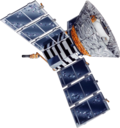Far Ultraviolet Spectroscopic Explorer (FUSE, Explorer 77, and MIDEX-0) represented the next generation, high-orbit, ultraviolet space observatory covering...
12 KB (1,184 words) - 21:05, 21 November 2024
Extreme Ultraviolet Explorer (EUVE or Explorer 67) was a NASA space telescope for ultraviolet astronomy. EUVE was a part of NASA's Explorer spacecraft...
17 KB (1,994 words) - 20:45, 26 November 2024
International Ultraviolet Explorer (IUE or Explorer 57, formerly SAS-D) was the first space observatory primarily designed to take ultraviolet (UV) electromagnetic...
59 KB (6,967 words) - 01:19, 23 February 2025
- Hopkins Ultraviolet Telescope (flew in 1990 and 1995) - ROSAT XUV (17-210eV) (30-6 nm, 1990–1999) - Far Ultraviolet Spectroscopic Explorer (90.5-119...
9 KB (863 words) - 04:03, 27 February 2025
UVEX (category Explorers Program)
The Ultraviolet Explorer (UVEX) is an upcoming wide-field ultraviolet space telescope from NASA scheduled to launch in 2030. UVEX will build off of previous...
10 KB (809 words) - 19:05, 17 January 2025
GALEX (redirect from Explorer 82)
Galaxy Evolution Explorer (GALEX or Explorer 83 or SMEX-7) was a NASA orbiting space telescope designed to observe the universe in ultraviolet wavelengths...
15 KB (1,625 words) - 04:51, 24 October 2024
Ultraviolet radiation, also known as simply UV, is electromagnetic radiation of wavelengths of 10–400 nanometers, shorter than that of visible light,...
124 KB (13,478 words) - 03:02, 24 May 2025
heavily involved with the Extreme Ultraviolet Explorer project. The Extreme Ultraviolet Explorer, a NASA explorer class satellite mission, was launched...
12 KB (1,158 words) - 00:56, 24 May 2025
Extreme ultraviolet radiation (EUV or XUV) or high-energy ultraviolet radiation is electromagnetic radiation in the part of the electromagnetic spectrum...
13 KB (1,518 words) - 20:17, 23 May 2025
The Cosmic Background Explorer (COBE /ˈkoʊbi/ KOH-bee), also referred to as Explorer 66, was a NASA satellite dedicated to cosmology, which operated from...
33 KB (3,842 words) - 00:43, 4 May 2025
environmental changes and global warming. The Tel Aviv University Ultraviolet Explorer (TAUVEX) is a space telescope array conceived by Noah Brosch of Tel...
50 KB (5,818 words) - 13:56, 9 March 2025
Ultraviolet Explorer space telescope. Since 2002 Weaver has worked at the Applied Physics Laboratory. He is co-investigator on the Alice ultraviolet imaging...
4 KB (326 words) - 19:35, 6 May 2025
Photokeratitis (redirect from Ultraviolet keratitis)
Photokeratitis or ultraviolet keratitis is a painful eye condition caused by exposure of insufficiently protected eyes to the ultraviolet (UV) rays from...
13 KB (1,360 words) - 05:45, 14 May 2025
chromospheric rotation of RS CVn and BY Dra stars with the International Ultraviolet Explorer satellite. Andrews, now retired, and his wife, Mette, live in Dore...
7 KB (861 words) - 20:53, 4 August 2024
the International Ultraviolet Explorer (IUE), the Extreme Ultraviolet Explorer (EUVE), the Far Ultraviolet Spectroscopic Explorer (FUSE), and the Galaxy...
28 KB (3,247 words) - 23:28, 10 March 2025
observations in the ultra-violet as early as 1962. The International Ultraviolet Explorer (1978) systematically surveyed the sky for eighteen years, using...
75 KB (9,307 words) - 04:49, 24 April 2025
star designation LW Hydrae. When observed in ultraviolet wavelengths by the International Ultraviolet Explorer, a very hot companion star was discovered...
6 KB (678 words) - 04:06, 25 November 2024
High Energy Transient Explorer 1 (HETE-1) was a NASA astronomical satellite with international participation (mainly Japan and France). The concept of...
8 KB (821 words) - 23:47, 31 March 2023
it can only be observed with satellites such as the International Ultraviolet Explorer. In 1977, Stencel published a spectroscopic survey that showed that...
6 KB (660 words) - 16:24, 7 February 2025
Berkeley, in 1979. He was principal investigator for the NASA Extreme Ultraviolet Explorer Satellite at the University of California, Berkeley. He is former...
6 KB (543 words) - 16:30, 13 February 2024
white dwarf binary TV Columbae using data from the International Ultraviolet Explorer. However the data was not sufficient to infer the physical mechanism...
5 KB (535 words) - 06:56, 11 November 2024
TAUVEX (redirect from Tel Aviv University Ultraviolet Explorer)
The Tel Aviv University Ultraviolet Explorer, or TAUVEX (Hebrew: טאווקס), is a space telescope array conceived by Noah Brosch of Tel Aviv University and...
10 KB (1,244 words) - 10:20, 25 October 2024
The Solar Mesosphere Explorer (also known as Explorer 64) was a 1980s NASA spacecraft to investigate the processes that create and destroy ozone in Earth's...
6 KB (331 words) - 17:21, 11 September 2024
Neil Gehrels Swift Observatory (redirect from Swift Gamma Ray Burst Explorer)
Gehrels Swift Observatory, previously called the Swift Gamma-Ray Burst Explorer, is a NASA three-telescope space observatory for studying gamma-ray bursts...
34 KB (4,079 words) - 01:12, 24 November 2024
the International Ultraviolet Explorer, the Hubble Space Telescope, the International Infrared Observer and the Extreme Ultraviolet Observer. Stern was...
30 KB (3,225 words) - 07:24, 24 May 2025
List of space telescopes (category Ultraviolet telescopes)
observatories) is grouped by major frequency ranges: gamma ray, x-ray, ultraviolet, visible, infrared, microwave, and radio. Telescopes that work in multiple...
129 KB (5,530 words) - 13:56, 26 May 2025
Goddard Space Flight Center he proposed to use the International Ultraviolet Explorer satellite to look for comets. Using the Haystack Observatory, Jackson...
19 KB (1,922 words) - 07:55, 7 April 2025
first all sky survey in the ultraviolet. Wilson was best known for his role as "father" of the International Ultraviolet Explorer (IUE) satellite. This had...
6 KB (550 words) - 15:31, 26 October 2024
IMAGE (spacecraft) (redirect from Explorer 78)
(Imager for Magnetopause-to-Aurora Global Exploration, Explorer 78 or MIDEX-1) was a NASA Medium Explorer mission that studied the global response of the Earth's...
37 KB (4,542 words) - 14:31, 11 May 2025
The Local Bubble was also the region of interest for the Extreme Ultraviolet Explorer mission (1992–2001), which examined hot EUV sources within the bubble...
21 KB (2,180 words) - 18:43, 6 May 2025
























